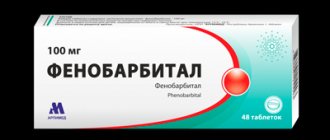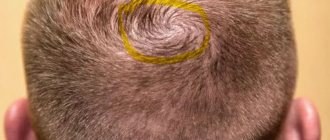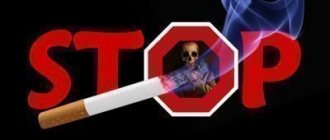Anonymously
Around the clock
Attention! The material contains information about substances, the use of which can cause serious harm to your health!
In the first weeks of quitting smoking, tobacco withdrawal occurs, which often causes relapses. A person who has firmly decided to quit a bad habit must know how to survive nicotine withdrawal and minimize poor health.
- What is nicotine withdrawal?
- Signs of withdrawal syndrome when quitting smoking
- Consequences of quitting smoking
- Quit smoking - blood pressure went down
- Quit smoking - headache, dizziness, drowsiness
- Quit smoking - back hurts
- Nasal congestion
- Depression when quitting smoking
- Sore throat, lump in throat, pain
- Panic attacks when quitting smoking
- Lost appetite, loss of strength
- I quit smoking and have chest pain
- How long does smoking cessation last?
- How to fight the urge to smoke
- Methods to combat smoking withdrawal syndrome
- Drug therapy for tobacco withdrawal
- Relieve withdrawal symptoms at home
- FAQ
- If you quit smoking, how can you not start drinking more?
- Quit smoking, but no cough. Why?
- I haven’t smoked for a month, but I still crave it. What to do?
- Treatment of nicotine addiction at the Zdravnitsa clinic in Moscow
We will select an individual treatment plan
Free consultation 8-800-200-27-23
What is nicotine withdrawal?
Withdrawal syndrome is the result of severe nicotine addiction. This condition suggests that for many years nicotine served as the body's main stimulant. In this regard, the cessation of nicotine intake causes some changes in the functioning of the body, as a result of which it is rebuilt into a “normal mode”. Popularly this phenomenon is called “withdrawal”, but experts call this phenomenon abstinence.
Nicotine withdrawal
When a person decides to quit smoking, within an hour after giving up he begins to be tormented by a wild desire to light a cigarette. This craving intensifies with each passing hour. Scientists have discovered that if a quitter has cigarettes left, he may well delay the time to smoke, and his body can easily tolerate this. If there are no supplies, the urge to smoke becomes unbearable. Although, in the presence of cigarettes, a dependent person is able to fight cravings only for a few hours.
A feature of nicotine withdrawal is its rapid onset.
Already from the first day, the patient experiences an irresistible craving for a cigarette, he is bothered by the following symptoms:
- Anxiety;
- Emotional stress;
- Excessive irritability;
- Depression and difficulty concentrating;
- A smoker experiences hand tremors;
- Headache;
- The pressure begins to jump;
- Shortness of breath and cough;
- Hunger increases, which cannot be eaten with food or washed down with coffee.
Such signs arise due to the cessation of nicotine entering the body, causing the body to begin to restore its normal activity.
Signs of withdrawal syndrome when quitting smoking
Nicotine withdrawal is accompanied by poor health. Withdrawal symptoms include not only discomfort and anxiety, but also other severe physiological reactions.
A person addicted to nicotine faces the following conditions:
- Cough and shortness of breath: Some people feel short of breath at night. These symptoms are caused by the self-cleaning of the lungs from poisons and tars;
- Anxiety, hand tremors;
- Insomnia;
- Heart rhythm disturbances;
- Hoarseness of voice;
- Pain in the back, teeth, migraine, etc.;
- Decreased or increased appetite. Often, such conditions are associated with a person’s emotional characteristics: in the absence of cigarettes, some people are accustomed to “eating” stress, while others’ appetite completely disappears;
- In the later stages of nicotine addiction, when quitting smoking, dizziness, apathy, chest pain and flushing of the skin occur.
If withdrawal symptoms are more intense, you should consult a specialist to improve your well-being.
HOW TO MOTIVATE A DEPENDENT FOR TREATMENT
Process flow
Nicotine withdrawal is quite difficult to overcome. It is divided into 3 stages, each of which has its own symptoms and duration: 24 hours, 6 days, 27 days. After this time, noticeable relief should occur. If the smoker has been smoking for more than 20 years, the symptoms may worsen.
- At the initial stage, characteristic symptoms are increased physical fatigue, decreased appetite, gastrointestinal disorders, sleep disturbances, and increased sweating.
- The second stage is characterized by swelling, surges in blood pressure, headaches, tremors in the limbs, lack of desire to work, and inability to concentrate on the task at hand.
- The third stage is final. At this stage, disruptions in the functioning of the gastrointestinal tract and cardiovascular system may occur. Depending on the smoking experience, improvements may be observed: physical and brain activity, increased mood.
Each smoker experiences nicotine withdrawal differently; some may experience complications from the immune system in the form of persistent acute respiratory viral infections. Often those who quit smoking develop mouth ulcers and increase body weight. On the mental side, after quitting nicotine, complications such as depression, communication problems, insomnia, anxiety, and asthenia can be observed.
Consequences of quitting smoking
The first signs of withdrawal may occur on the first day of quitting smoking. Despite the initial discomfort, the decision to quit smoking has a positive effect on a person’s health: quitting smoking will help restore the health of the respiratory, cardiovascular and nervous systems. Having survived the difficult period of withdrawal syndrome, you can completely give up cigarettes, replace them with a healthy diet, physical activity and active recreation.
Quit smoking - blood pressure went down
Often, after giving up cigarettes, the addict becomes weak and dizzy. The fact is that with prolonged smoking, nicotine plays the role of a stimulant in the body, increases heart rate and increases blood pressure. As a result of hypertension, the smoker gets feverish, hand tremors occur, and it becomes difficult to breathe.
To increase blood pressure, some people drink caffeinated drinks. This decision has a detrimental effect on the cardiovascular and nervous system, and the stimulating effect of coffee quickly wears off. Consult your doctor to replace nicotine with “healthy” stimulants, such as eleuthero, ginseng decoction, etc.
Quit smoking - headache, dizziness, drowsiness
Drowsiness and dizziness in smoker's syndrome are associated with a drop in blood pressure and a decrease in the overall tone of the body. In addition, headaches and dizziness when quitting cigarettes are often associated with the launch of “reverse processes”: the body is intensely saturated with oxygen, which can lead to unpleasant conditions. This symptom disappears a few days after quitting cigarettes.
Headache after smoking occurs as a result of cerebral vascular spasm: this is a dangerous condition that can lead to a stroke. This means that deciding to quit smoking will help manage chronic migraines and prevent the onset of acute migraines.
Quit smoking - back hurts
In some cases, during nicotine withdrawal, the skin on the back itches and pain in the spine is noted. This is due to the following reasons:
- Nervousness contributes to muscle strain, resulting in pain;
- Psychosomatics. The expectation of physical discomfort contributes to its appearance: as a result of “self-programming,” a person’s legs ache, back discomfort appears, and the temperature may even rise;
- Painful symptoms may indicate the presence of a disease of the musculoskeletal system. Surprisingly, nicotine can block some pain impulses that signal back problems. Its absence simply reveals pathology.
Regardless of the intensity of the pain, if it occurs, you should consult a doctor. Early detection and treatment of diseases will help prevent their development.
Find out treatment recommendations without leaving home for free
To select a treatment plan, you just need to leave a request, we will contact you to select the time and specialist you need
Submit your application
Nasal congestion
Nasal congestion is a common symptom of nicotine withdrawal. Nicotine promotes vasodilation, and its absence causes vasoconstriction. The fact is that due to an imbalance in the ratio of oxygen and carbon dioxide in the body, swelling of the nasal mucosa (stuffiness) occurs.
This may be accompanied by swelling of the face, bleeding from the nose, bad breath, etc. A good way to get rid of congestion is to visit an ENT specialist, use special drops and start exercising to improve oxygen metabolism.
Depression when quitting smoking
It is widely believed that cigarettes are the smoker's main sedative. In fact, nicotine is a powerful stimulant of the nervous system, supporting its functioning. After quitting smoking, a person feels drowsiness, weakness in the legs and a depressed mood. This occurs due to changes in biochemical processes in the brain. If depression develops, you must do the following:
- Contact a psychiatrist-narcologist. Specialists will help reduce the intensity of withdrawal symptoms and improve a person’s well-being. The doctor will prescribe high-quality antidepressants and prescribe psychotherapy;
- Fight anxiety with the right methods: meditate, switch your attention to a healthy lifestyle.
Sore throat, lump in throat, pain
During the period of abstinence, the addict’s body is cleansed of accumulated combustion products: toxins and other aggressive substances are eliminated through the throat, contributing to the appearance of pain impulses. Sore throat and pharyngitis develop: symptomatic treatment is necessary. The pain and feeling of a lump in the throat go away after some time after quitting smoking.
A sore throat while smoking is associated with drying of the mucous membrane of the throat: pharyngitis develops. As a result, local immunity decreases and the incidence of infectious diseases increases. If dryness occurs after quitting smoking, it is worth visiting an ENT specialist, performing herbal inhalations and rinsing the throat.
Panic attacks when quitting smoking
A panic attack is a serious condition that is accompanied by severe horror and panic. A panic attack can be caused by exposure to “triggers” (irritants), or occur on its own. During withdrawal, the functioning of the nervous system is restructured, which can lead to panic attacks. In order to help yourself during a panic attack, it is not enough to take Afobazol and other pharmaceuticals: you should consult a specialist to study the causes of panic attacks and their treatment.
Lost appetite, loss of strength
Poor health and loss of appetite are caused by a decrease in body tone. Relief from this syndrome should be carried out in combination with comprehensive treatment of nicotine addiction and abstinence.
I quit smoking and have chest pain
Chest pain is also associated with self-cleansing: the respiratory system removes toxins, tars and other harmful elements in order to normalize function. Natural detoxification is accompanied by night sweats, weakness, coughing and chest pain. During this period, you can help yourself in this way:
- Try to drink still water more often;
- Take a walk in the fresh air;
- Consume more protein foods;
- Avoid secondhand smoke.
Symptoms of nicotine addiction
Starting to smoke, as a rule, causes unpleasant sensations: a sore throat, nausea, and sometimes vomiting, but if you continue systematic smoking, they are gradually reduced and nicotine addiction develops, which has three characteristic symptoms:
- First, stopping the use of nicotine initiates the development of withdrawal symptoms , which peak within 24-48 hours after quitting smoking. Its symptoms are as follows: anxiety, sleep disturbances, irritability, impatience, craving for smoking, impaired concentration, increased appetite and headache.
- Second, smoking has powerful psychological motivations (such as relieving stress or preventing boredom). Corresponding behavioral reactions (lighting a cigarette, inhaling smoke, etc.) are reinforced as a result of activation of the central nervous system by nicotine.
- And thirdly, the effect of nicotine on the brain causes subjectively pleasant sensations in the smoker. The three above-mentioned aspects sometimes make stopping tobacco abuse extremely difficult for patients with such addiction.
Up
How to fight the urge to smoke
Experts recommend developing “rituals” that replace smoking cigarettes. For example, instead of smoking a morning cigarette, train yourself to eat one apple, drink a glass of water, do squats, etc.
If the desire to smoke brings too much discomfort, contact a drug treatment clinic. A doctor will help you cope with nicotine addiction and survive withdrawal.
Treatment
On the basis of rehabilitation, effective treatment of withdrawal syndrome in alcoholism is carried out. The type of therapy depends on the symptoms and the presence of pathologies. If a hangover is overcome with adsorbent medications, then relieving withdrawal symptoms in alcoholism is impossible without a narcologist.
In rehabilitation, a certain algorithm is followed.
- Elimination of symptoms using drips and intravenous injections.
- Special tablets are prescribed that remove toxins from the blood and liver. You cannot buy these medications on your own; they must be prescribed by a doctor.
- Tablets with a sedative effect help normalize sleep.
- Preventive measures aimed at preventing complications.
Without psychotropic medications, it will not be possible to completely get rid of withdrawal symptoms. Treatment aimed at restoring psychological and physical health.
Methods to combat smoking withdrawal syndrome
The Treatment and Rehabilitation Center “Zdravnitsa” offers the following professional methods of tobacco withdrawal therapy:
- Drug therapy;
- Psychotherapy;
- Exercise therapy, yoga;
- Hardware recovery techniques.
Our specialists provide professional drug treatment services, provide an individual approach to each person and modern methods of therapy.
Drug therapy for tobacco withdrawal
Drug therapy is aimed at relieving withdrawal symptoms, accelerating detoxification of the body, and normalizing the psycho-emotional background. The specialist uses medications for enteral administration, injections, infusion solutions, etc., based on the severity of the situation and the characteristics of taking the medication. The following groups of drugs are often used:
- Sedatives;
- Antidepressants;
- Antihypertensive drugs;
- Analgesics;
- Water-salt solutions for infusion;
- Sorbents, etc.
Relieve withdrawal symptoms at home
Mild withdrawal goes away on its own after some time. You can drink herbal teas and mild sedatives to reduce mental stress and relax. Exercising helps to shift attention from the desire to smoke to restoring health. If these methods do not help and the withdrawal symptoms are severe, call the Zdravnitsa specialists to your home.
Features of the state of withdrawal syndrome
Waking up after celebrating something and feeling the consequences of excessive drinking, a person is unlikely to think about treating alcoholism. After all, many people have hangovers.
Withdrawal syndrome is often disguised as this condition, although there are still differences:
- — The hangover subsides by the evening of the same day, and withdrawal symptoms last 3-5 days.
- — A new portion of alcohol relieves withdrawal symptoms, but with a hangover there is no noticeable improvement in the condition after that.
- — Manifestations of withdrawal syndrome impair the ability to work, the patient’s physical and emotional state cannot be controlled by him.
- — Attempts to get rid of withdrawal symptoms on your own (most often by drinking a glass of alcohol) lead to a new binge.
FAQ
If you quit smoking, how can you not start drinking more?
In some cases, after quitting smoking, a person begins to drink more alcohol. One addiction is replaced by a second, and the quality of life deteriorates. In order to minimize the risk of alcoholism after quitting nicotine, contact the specialists of the Zdravnitsa center: a narcologist and a psychotherapist will help identify and work through the causes of addiction and maintain general sobriety.
Quit smoking, but no cough. Why?
The absence of a cough when quitting smoking should not scare you: “smoker’s bronchitis” does not appear in every person who gives up cigarettes.
I haven’t smoked for a month, but I still crave it. What to do?
This situation is closely related to the development of psychological dependence on smoking. You should work through the reason for craving for cigarettes together with a psychotherapist. This often hides increased anxiety, depression and boredom. A specialist will help you work through the root cause of your addiction and cope with the craving for smoking.
How to ease withdrawal symptoms and get rid of tobacco addiction?
Practice shows that only a few manage to quit nicotine on their own. Most smokers return to this path again several months or even years after quitting. Therefore, they are often recommended to seek help from narcologists in a specialized clinic. The fight against smoking there is usually based on the fact that the patient is given medications with nicotine to ease withdrawal, and at the same time there is work with a psychotherapist. Today, the most popular tactic is “5A”, which includes the following steps:
1. Ask. Collecting information about the patient, finding out the current smoking status (how many cigarettes does he smoke per day, how long has he been smoking, and so on).
2. Advise. The specialist tells the patient about the dangers of smoking, shows shocking photos of a smoker’s lungs, tells sad stories from his practice, in other words, tries to intimidate.
3. Assess. At this stage, the patient's motivation for treatment is assessed. This is usually done using a survey.
4.Assist. The specialist draws up an individual treatment plan, suggests certain medications, and coding methods.
5. Arrange. In parallel, individual and group sessions with a psychotherapist are conducted.
Unfortunately, the results of this technique still leave much to be desired, since cases of relapse are quite common. In addition, one of the main postulates of such therapy is the assertion that the best remedy for alleviating withdrawal symptoms is nicotine. Therefore, patients are prescribed patches, sprays, lozenges, and chewing gum containing it to make withdrawal gradual and painless. But in reality, very often this does not help, and after completing the course of treatment the person starts smoking again.
So what to do? Fortunately, there is a simpler method of quitting smoking, which has been demonstrating the highest effectiveness for several decades. This is "The Easy Way to Quit Smoking" by Allen Carr.
How to get to us
To learn more about the features of tobacco addiction therapy, contact the managers of the Zdravnitsa treatment and rehabilitation center. Use the phone number or special field on the website.
Leave a request for a free consultation with a specialist
We will contact you as soon as possible
- — Anonymous
- - For free
- — Around the clock
Article verified by an expert
Terekhova Anna Vladimirovna
psychologist-consultant on socio-psychological work with addicted clients and their families. More than 10 years of experience.
Similar articles:
Consequences of drug use on human health
Tramadol: what is it, the effect and consequences of use
Death by heroin
21 recommendations on how to deal with an addict during the recovery process
Amphetamine: what it is, the effect and consequences of use
How to relieve withdrawal symptoms after hashish
Considering that the withdrawal syndrome after hashish lasts quite a long time and creates conditions for repeated use of the drug, it is necessary to help the patient overcome it as quickly as possible. Unfortunately, folk remedies are useless here. The only one who can ease the course of abstinence in a drug addict is a narcologist. Therefore, it is necessary to take the addict to an inpatient drug clinic or call a private drug treatment ambulance to his home.
The danger is that very often, in an attempt to cope with withdrawal symptoms, people agree to take “harder” drugs . Therefore, under no circumstances should you delay treatment.
infusion therapy to treat withdrawal symptoms in hashish patients . The patient is placed on a drip, which speeds up the process of cleansing the body of the stimulant and its metabolites. In severe cases, physiotherapy is included in the therapeutic program.
After infusion treatment, a person’s physical and psychological condition improves. Then an experienced psychologist begins to work with him.
During group and individual psychological consultations, the client begins to understand what pushed him to drug addiction. Work begins with the root cause of addiction. After eliminating its harmful effects, the likelihood of relapse is significantly reduced.
Additionally, the psychologist teaches the skills of relaxation, self-control, switching attention, explains how to communicate correctly with others, how to say “no”. All this knowledge helps a hashish addict gain self-confidence and successfully enter a new life.









